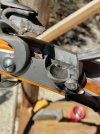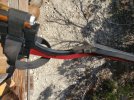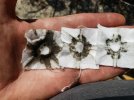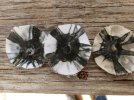Been a while. I finally got to the range again today with a new powder and I think I've finally gotten it right.
Things I changed:
- Cleaned the blender and put my granulated KNO3 in it for a couple of minutes to make it airfloat grade. It needs to be really dry to do this, mine was fresh from the package but an hour in a warm oven (150 degrees or so) would help.
- Still using the higher-speed mill as previous.
- Milled all three ingredients together for only 10 hours this time. Finished powder meal felt wet between fingers it was so slick. NO gritty whatsoever.
- Changed the ratio to 78/13/9.
- Same Black Willow charcoal as before, powdered in the blender.
- Same puck pressure, about as much as my 20 ton press can give, hold for 20-30 seconds, maybe one drop or less of water squeezing out around the base (two capfulls of Ozarka water per half pound meal).
Now, I ground two batches. First one was right after pucking, it was damp enough to clog up the grinder disc faces and just sort of crush though. It was a mess and I didn't have high hopes for it after weighing in at around 40 grains per 50 volume. Second half of the batch I re-pucked and ground after it had dried for only a couple of hours. MUCH better grind, still a little clumpy going through the screens but acceptable. Second half came out about 47.5 grains weight per 50 measure. This changed a little after drying the granulated powders and re-screening.
Both batches were dried on a cookie sheet and re-screened to remove dust. Still grading 3F at 20/50.
Took the scale to the range with me this time. Short version, batch B ground drier was shot first and gave me about 1585 fps at 50 grains volume/47.5 grains weighed and 1650 fps at 55 grains volume/51 grains weighed. Was getting a little erratic velocity due to bullet seating issues, slight carbon ring in "chamber". That got better when I seated the ball with the short starter on the end of the ramrod. Pretty dang clean though, happy enough with the performance overall. Batch A was shot next after cleaning and I ran 16 shots through. This stuff was coming out 50 grains for a 55 measure at the range if I poured the measure to overflow and tapped it a couple times to level the powder. This gave me virtually the same velocity average at virtually the same WEIGHT.
The difference between the densities was how clean the less dense, batch A shot. This was by far the cleanest black powder I've EVER shot, any grade, any brand. 16 rounds and NO carbon ring. When I finished I ran a dampened patch to the breech plug with almost no resistance, jogged it a few times, and pulled it out to find only one little flake of fouling, the rest was soft dust that wiped right out. A dry patch following that and I was ready to shoot again. Simply amazing. I primed both batches with the charge powder and it worked fine at only 9% sulfur, no problems whatsoever. Pan and barrel had only light soot, no white coating and not much smoke. The smoke cloud from the muzzle was perhaps half of what any other powder has produced and the MagnetoSpeed bayonet stayed quite clean after 20+ shots with only a slight carbon accumulation on the shield and virtually none on top of the sensor plane.
In conclusion, lower density makes cleaner burn. More KNO3 makes cleaner burn. Better milling makes cleaner burn and more power. Weighing charges, regardless of density, gives better consistency batch to batch regardless of process (same recipe, same weight, variable density, all yields same velocity).







